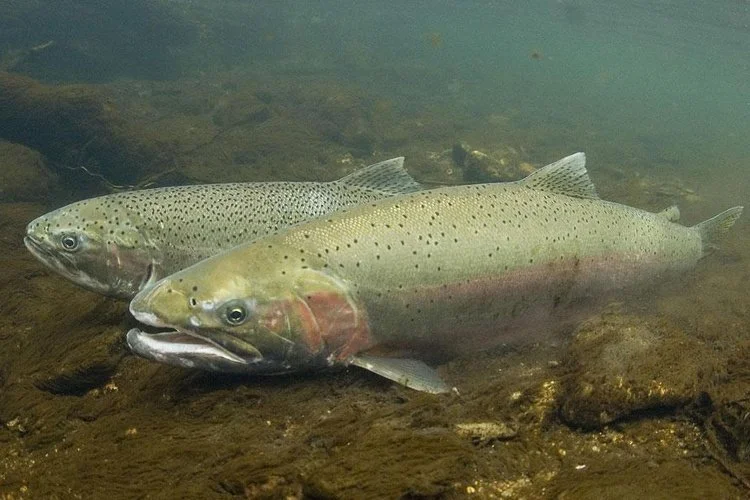Ecology & Biodiversity
The Wild Gaviota Coast
Encompassing nearly an entire coastal watershed, Rancho Tajiguas Preserve spans over 1,600 acers of wildlands including Coastal Sage-Chaparral Scrub and other important native vegetation communities. Over 800 acres of grasslands support native bunchgrasses and foraging raptors. A perennial watercourse, Tajiguas Creek, sustains rare and endangered wildlife species and provides a corridor for wildlife to traverse from the Los Padres National Forest down to the Pacific Ocean.
Environmentally Sensitive Habitat
Grasslands
Rare Plants
Plant Communities
Tajiguas Canyon supports distinct plant communities among the parallel bands of sedimentary geologic layers that traverse the site parallel to the coast.
Wildlife and Wildlife Corridors
Tajiguas Creek flows through one of the most ecologically important corridors on the Gaviota Coast, sustaining rare wildlife and connecting mountain habitats to the sea.
Habitat
Riparian System
Explore Special Species of Concern
Environmentally Sensitive Habitat
Many of these native plant communities are considered Environmentally Sensitive Habitat (ESH) and four - sycamore-coast live oak riparian woodland, coast live oak woodland, riparian scrub, and perennial needlegrass - are habitats of special concern. Coast live oak woodland, a climax plant community found in abundance on Rancho Tajiguas Preserve, is particularly important for its ability to support a wide variety of wildlife species.
Coastal sage-chaparral scrub habitat, a mosaic of woody chaparral species and sage scrub species along the slopes, is the most abundant vegetation community with California sagebrush, coyote brush, buck brush, greenbark ceanothus, sticky monkeyflower, deerweed, chamise, and toyon as dominant species.
Grasslands
In addition to these native plant communities, Rancho Tajiguas Preserve also includes over 800 acres of grasslands comprised of California annual grasses, with patches of native perennial grass species including purple needlegrass (Stipa pulchra), California melic (Melica imperfecta), and California brome (Bromus carinatus).
SBCC Professor Mike Gonella points out native perennial purple needlegrass amongst the annual grasses at Rancho Tajiguas Preserve to students (November 6, 2024)
Rare Plants
Two special-status plant species, Santa Barbara honeysuckle (Lonicera subspicata var. subspicata) and southern California black walnut (Juglans californica), have been observed and mapped during previous field surveys, and at least seven additional special-status plant species are likely to occur on Rancho Tajiguas Preserve based on suitable habitat, soil types, and/or nearby populations including late-flowered mariposa lily (Calochortus fimbriatus), Southern tarplant (Centromadia parryi ssp. australis), Gaviota tarplant (Deinandra increscens ssp. villosa), umbrella larkspur (Delphinium umbraculorum), Ojai fritillary (Fritillaria ojaiensis), black-flowered figwort (Scrophularia atrata), and chaparral ragwort (Senecio aphanactis).
Santa Barbara Honeysuckle growing at Rancho Tajiguas
Plant Spotlight
Santa Barbara Honeysuckle (Lonicera subspicata var. subspicata)
Santa Barbara honeysuckle is a rare and locally treasured species, recognized by the California Native Plant Society as a plant of high conservation concern (Rank 1B.2). Found only in Santa Barbara and Los Angeles counties and on Santa Catalina Island, its limited range makes every remaining population vital.
This perennial evergreen shrub, with its twining or reclining stems and narrow leaves, blooms in delicate profusion each spring between April and May. It thrives in chaparral, coastal scrub, and woodland below 3,300 feet.
Rancho Tajiguas Preserve has well established populations of Santa Barbara honeysuckle, consisting of large shrubs with thousands of stems. Their presence is a reminder of what careful stewardship can preserve.
Habitat
Tajiguas Creek and its tributaries provide a unique habitat resource that is regionally restricted and is essential to several rare or very uncommon wildlife species, including Southern steelhead (Oncorhynchus mykiss irideus), California red-legged frog (Rana draytonii), Two-striped garter snake (Thamnophis hammondii), and Southwestern Pond Turtle (Actinemys pallida). This system also provides a crucial link between the higher elevation foothills of the Santa Ynez Mountains and the coastal plain. Wildlife dispersal, migration, and genetic continuity and interchange are facilitated by the Tajiguas Creek drainage.
The expanse of largely undeveloped land with interspersed orchard blocks allows for movement and dispersal of wide-ranging carnivores such as mountain lion (Felis concolor) and black bear (Ursus americanus). Other mammalian predators and scavengers include bobcat (Lynx rufus), coyote (Canis latrans), and gray fox (Urocyon cinereoargenteus). Black-tailed deer (Odocoileus hemionus columbianus) are common. The extensive annual grasslands also provide foraging habitat for several birds of prey, including resident species such as red-tailed and red-shouldered hawk (Buteo jamaicensis and B. lineatus) and American kestrel (Falco sparverius).
Tajiguas Creek Ecosystem
Tajiguas Creek is a perennial stream that flows, along with its tributaries, through the central portion of the property in a southerly direction, ultimately discharging to the Pacific Ocean. The largest of the western tributaries is known as Leon Canyon. Tajiguas Creek terminates in a small coastal lagoon, after passing through a large culvert beneath U.S. Highway 101 and the Union Pacific Railroad.
Tajiguas Creek supports two federally-listed species, the California red-legged frog and tidewater goby, and southwestern pond turtle which was recently determined eligible for listing under the Endangered Species Act (ESA). Southern steelhead, also listed as federally endangered, was observed in the lagoon at the mouth of the creek as recently as 2001 and are likely to have historically used the creek for spawning. Two semi-aquatic herptile “species of special concern”, the Coast Range newt, and two-striped garter snake, are also known to inhabit Tajiguas Creek
Explore Species
Rancho Tajiguas Preserve is home to mammals, birds, amphibians, and fish.
Male and female steelhead trout. Credit: NOAA Fisheries
Southern Steelhead – Southern California ESU (Oncorhynchus mykiss irideus).
The Southern California Steelhead Distinct Population Segment is listed as endangered under the Federal ESA. It is also considered a Species of Special Concern by CDFW. Steelhead trout are anadromous – much of their life cycle is pelagic, but they rely on freshwater streams and rivers for spawning and rearing. Southern steelhead formerly inhabited several perennial streams along the Gaviota Coast.
There is one recorded observation of steelhead in the lagoon at the mouth of Tajiguas Creek in June and July of 2001; areas in the lower reaches of such streams are important for rearing juvenile steelhead and for enabling acclimation to a more saline environment prior to entering the ocean.
An assessment of steelhead habitat quality and extent within the Tajiguas Creek watershed (Stoecker 2010) was completed in support of the Draft Watershed Management Plan prepared by Sage Associates (2014). The upper reaches of Tajiguas Creek were determined to support some areas of excellent steelhead spawning habitat.
California Red-legged Frog (Rana draytonii).
The California red-legged frog (CRLF) is listed as threatened under the Federal ESA and is considered a Species of Special Concern by the California Department of Fish and Wildlife (CDFW). Preferred habitats for the CRLF consist of freshwater marshes and streams with thick growths of emergent vegetation (most frequently willow and to a lesser extent, cattail) in association with “plunge” pools of moderately deep water. Willows and pools allow escape from predators and provide harborage within the tangled structure of willow roots lining the banks of the stream. Adult, subadult, and larval specimens have all been observed, suggesting that Tajiguas Creek supports a healthy CRLF population.
Tidewater Goby (Eucyclogobius newberryi).
The tidewater goby is listed as endangered under the Federal ESA and is also considered a Species of Special Concern by CDFW. Tidewater goby inhabits the lower reaches of streams and coastal lagoons. Tidewater gobies are known in Arroyo Quemada Creek, approximately 1.25 miles west of Tajiguas Canyon, and Refugio Creek, approximately 2.25 miles east of Tajiguas Canyon and have been observed in the coastal lagoon of Tajiguas Creek.
Coast Range Newt (Taricha torosa torosa).
The Coast Range newt is considered a Species of Special Concern by the CDFW. Coast range newts breed in ponds and reservoirs, and reside in terrestrial habitats during the non-breeding season (fall and winter). Coast range newts have been observed in the middle reach of Tajiguas Creek.
Southwestern Pond Turtle (Actinemys pallida).
The southwestern pond turtle is a CDFW Species of Special Concern and was recently determined to be eligible for listing under the federal ESA as threatened. Southwestern pond turtle is most often found in streams, ponds, or other permanent or ephemeral water bodies. Retreat sites such as rocks, logs, and mats of emergent vegetation are used to avoid predation and for estivation. These same features are favored for basking during daytime, especially when associated with “plunge pools”. Southwestern pond turtles have been observed in Tajiguas Creek in the upper, mid, and lower reaches of the creek, most often in pools below road crossings. A maximum of nine individuals were recorded in one pool and a juvenile was also observed, indicating that the stream supports a healthy pond turtle population.
Two-striped Garter Snake (Thamnophis hammondii).
The two-striped garter snake is a CDFW Species of Special Concern. This species is typically found in or near permanent or intermittent freshwater, often along streams with rocky beds bordered by willows or other streamside vegetation. Two-striped garter snake has been observed in Tajiguas Creek.











